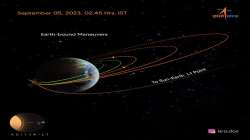Solar mission: Aditya-L1 successfully undergoes second Earth-bound manoeuvre, says ISRO
The spacecraft will undergo two more Earth-bound orbital manoeuvres before placing in the transfer orbit towards the Lagrange point L1.

In its latest statement, the Indian Space Research Organisation (ISRO) said that Aditya-L1 had successfully undergone the second Earth-bound manoeuvre during the early hours on Tuesday. "The second Earth-bound manoeuvre (EBN#2) is performed successfully from ISTRAC, Bengaluru. ISTRAC/ISRO's ground stations at Mauritius, Bengaluru and Port Blair tracked the satellite during this operation. The new orbit attained is 282 km x 40225 km (sic)," ISRO wrote on 'X' (formerly known as Twitter).
The space agency further said that the next manoeuvre (EBN#3) is scheduled for September 10, 2023, around 02:30 Hours (IST). Earlier on September 3, Aditya-L1 successfully performed the first Earth-bound manoeuvre of the country's maiden solar mission. The space agency had said that the satellite is healthy and operating nominally.
Aditya-L1 to go two more Earth-bound orbital manoeuvres
The spacecraft will undergo two more Earth-bound orbital manoeuvres before placing in the transfer orbit towards the Lagrange point L1. Aditya-L1 is expected to arrive at the intended orbit at the L1 point after about 127 days.
It should be noted here that Aditya-L1 is the first Indian space-based observatory to study the Sun from a halo orbit around the first sun-earth Lagrangian point (L1), which is located roughly 1.5 million km from Earth. Earlier on September 2, ISRO's Polar Satellite Launch Vehicle (PSLV-C57) successfully launched the Aditya-L1 spacecraft, from the Second Launch Pad of Satish Dhawan Space Centre (SDSC), Sriharikota.
Aditya-L1 successfully injected into elliptical orbit
After a flight duration of 63 minutes and 20 seconds, the Aditya-L1 spacecraft was successfully injected into an elliptical orbit of 235x19500 km around the Earth. Aditya-L1 carried seven scientific payloads indigenously developed by ISRO and national research laboratories including the Indian Institute of Astrophysics (IIA), Bengaluru, and Inter-University Centre for Astronomy and Astrophysics (IUCAA), Pune.
The payloads are to observe the photosphere, chromosphere and the outermost layers of the Sun (the corona) using electromagnetic particle and magnetic field detectors. Using the special vantage point L1, four payloads directly view the Sun and the remaining three payloads carry out in-situ studies of particles and fields at the Lagrange point L1, thus providing important scientific studies of the propagatory effect of solar dynamics in the interplanetary medium, ISRO stated.
(With inputs from PTI)
ALSO READ: Aditya-L1: PM Modi congratulates ISRO over India's first solar mission launch